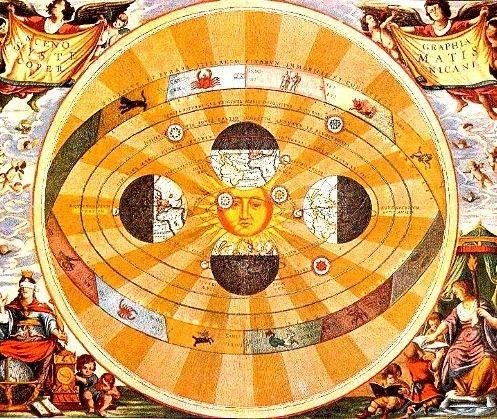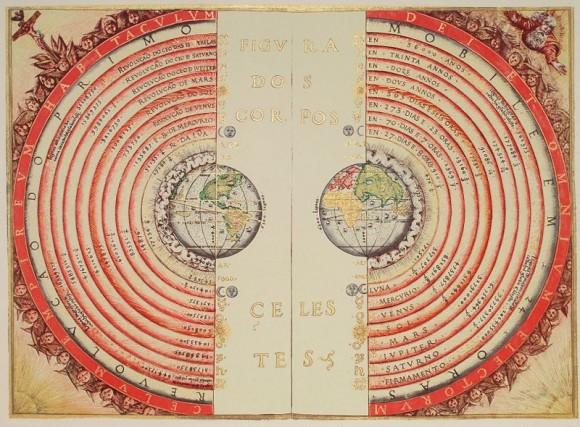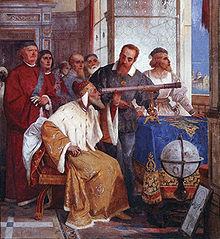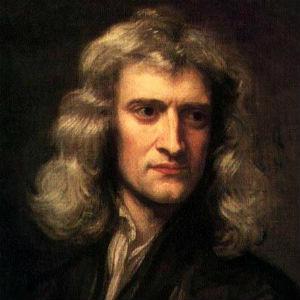Instructions for Side by Side Printing
- Print the notecards
- Fold each page in half along the solid vertical line
- Cut out the notecards by cutting along each horizontal dotted line
- Optional: Glue, tape or staple the ends of each notecard together
Ch. 22 Enlightenment and Revolution
front 1 Scientific Revolution | back 1 A new way of thinking about the natural world based on careful observation and a willingness to question old ideas that developed in the mid-1500s. |
front 2 heliocentric theory | back 2  Theory that the sun is at the center of the universe developed by Polish astronomer Nicolaus Copernicus in the early 1500s. He feared opposition by the Catholic Church and did not publish his theory until just before his death.
|
front 3 geocentric theory | back 3  Long-held theory that the Earth was the center of the universe. (This was disproved by German mathematician Johannes Kepler in the 1600s). |
front 4 Galileo Galilei | back 4  Scientist who was forced by the Catholic Church to take back scientific ideas that disagreed with the church's views. |
front 5 scientific method | back 5 Lgocial procedure for gathering and testing ideas; starting with a hypothesis and then testing whether it is supported by facts by experiments. English writer Francis Bacon said scientists should base thinking on what they can observe and test. French mathematician Rene Descartes promoted thinking based on logic and mathematics. |
front 6 Isaac Newton | back 6  An English scientist who in the 1600s discovered laws of motion and gravity, including that gravity causes the movement of planets, all matter on earth and in space. |
front 7 Enlightenment | back 7 An intellectual movement in which thinkers tried to apply reason and the scientific method to laws that shaped human actions. |
front 8 social contract | back 8 English writer Thomas Hobbes believed that people would war against each other without government. He believed people had a "social contract" in which they gave up their rights to the government in exchange for a safe and orderly society. A strong king who could force everyone to obey would be the best government, Hobbes said. |
front 9 John Locke | back 9 An English writer who believed that people have three rights: life, liberty and property. If the government fails to protect these rights, the people have the right to overthrow the government, he said. |
front 10 philosophes | back 10 French thinkers who had five main beliefs: 1: thinkers can find the truth by using reason; 2: what is natural is good and reasonable and human actions are shaped by natural laws; 3:acting according to nature can bring happiness; 4: by taking a scientific view, people can make progress and achieve a better life; and 5: by using reason, people can gain freedom. |
front 11 Voltaire | back 11 The most brilliant of the philosophes. He fought for tolerance, reason, freedom of religious belief and freedom of speech. |
front 12 Baron de Montesquieu | back 12 A great philosophe would promoted separation of powers -- dividing power among the separate branches of government. |
front 13 Jean Jacques Rousseau | back 13 A great philosophe would favored human freedom and believed all people were equal. |
front 14 Cesare Beccaria | back 14 An Italian philosophe who spoke out against abuses, including the abolishment of torture. |
front 15 Mary Wollstonecraft | back 15 British writer who promoted the rights for women at a time when most Enlightenment thinkers did not include women in their equal rights. |
front 16 salon | back 16 Social gathering places for thinkers and artists in in Paris in the 1700s. Ideas about the Enlightenment were spread at the salons. |
front 17 baroque | back 17 A very grand and ornate style of painting and architecture. |
front 18 neoclassical | back 18 A new style of simple but elegant painting and architure in the late 1700s that borrowed ideas from classical Greek and Roman design. (neo = new)This was also the time of classical music from Haydn, Mozart and Beethoven. |
front 19 enlightened despots | back 19 Rulers who supported enlightenment ideas but did not give up power. Many Enlightenment thinkers supported monarchies as the best government if rulers were willing to respect people's rights. |
front 20 Catherine the Great | back 20 Russian rules who supported the Enlightenmen.t She wanted to end serfdom and modernize Russia. But after a bloody peasant revolt, she gave more power to the nobles. |
front 21 Declaration of Independence | back 21 A 1776 document declaring American independence from Britain. It drew heavily on ideas from the Enlightenment and resulted from a meeting or congress of representatives from the 13 colonies. |
front 22 Thomas Jefferson | back 22 author of the Declaration of Independence |
front 23 checks and balances | back 23 The American Constitution, written in 1787, drew on Montesquieu's ideas of separation of powers to develop separate executive (president), judical (courts) and legislative(Congress) branches to prevent any branch from abusing its powers. |
front 24 federal system | back 24 A system of government in which powers are divided between the national and state governments. |
front 25 Bill of Rights | back 25 The first 10 amendments to the U.S. Constituion, which protect basic rights for people. |